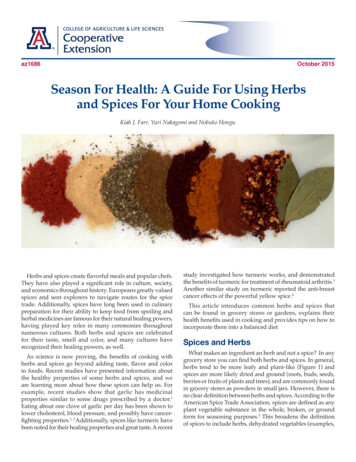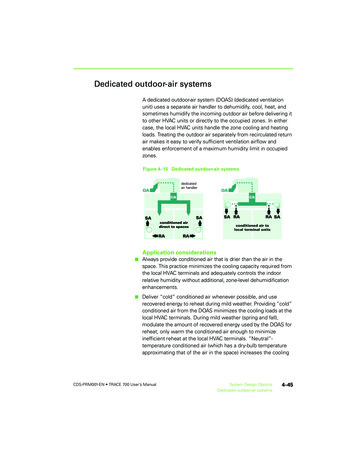
Transcription
az1686October 2015Season For Health: A Guide For Using Herbsand Spices For Your Home CookingKiah J. Farr, Yuri Nakagomi and Nobuko HonguHerbs and spices create flavorful meals and popular chefs.They have also played a significant role in culture, society,and economics throughout history. Europeans greatly valuedspices and sent explorers to navigate routes for the spicetrade. Additionally, spices have long been used in culinarypreparation for their ability to keep food from spoiling andherbal medicines are famous for their natural healing powers,having played key roles in many ceremonies throughoutnumerous cultures. Both herbs and spices are celebratedfor their taste, smell and color, and many cultures haverecognized their healing powers, as well.As science is now proving, the benefits of cooking withherbs and spices go beyond adding taste, flavor and colorto foods. Recent studies have presented information aboutthe healthy properties of some herbs and spices, and weare learning more about how these spices can help us. Forexample, recent studies show that garlic has medicinalproperties similar to some drugs prescribed by a doctor.1Eating about one clove of garlic per day has been shown tolower cholesterol, blood pressure, and possibly have cancerfighting properties.1, 2 Additionally, spices like turmeric havebeen noted for their healing properties and great taste. A recentstudy investigated how turmeric works, and demonstratedthe benefits of turmeric for treatment of rheumatoid arthritis.3Another similar study on turmeric reported the anti-breastcancer effects of the powerful yellow spice.4This article introduces common herbs and spices thatcan be found in grocery stores or gardens, explains theirhealth benefits used in cooking and provides tips on how toincorporate them into a balanced dietSpices and HerbsWhat makes an ingredient an herb and not a spice? In anygrocery store you can find both herbs and spices. In general,herbs tend to be more leafy and plant-like (Figure 1) andspices are more likely dried and ground (roots, buds, seeds,berries or fruits of plants and trees), and are commonly foundin grocery stores as powders in small jars. However, there isno clear definition between herbs and spices. According to theAmerican Spice Trade Association, spices are defined as anyplant vegetable substance in the whole, broken, or groundform for seasoning purposes.5 This broadens the definitionof spices to include herbs, dehydrated vegetables (examples,
Figure 1. Common leafy herbs (left to right: Italian parsley, rosemary, basil, thyme, oregano)garlic and onion), spice blends and spice seeds. Besides thesedefinitions, some plants yield both an herb and a spice. Forexample, dill weed (an herb) and dill seed (a spice) come fromthe same plant, but the American Spice Trade Associationdefines both as spices.5HerbsMore than just leafy greens, these plants are perhaps thelongest-used flavoring ingredients. Again, herbs tend to befresh-looking, small plants (or roots) (Figures 1). However,ground and dried versions of herbs are also commonlysold, and are sometimes more potent than their leafy green(or whole root) counterparts. (Figure 2) Fresh herbs areavailable at most grocery stores in the produce section, andare usually sold by the small bundle. When purchasing herbs,choose plants without any wilted or brown leaves or stems.Store fresh herbs in a cup or a vase with water (Figure 1) orwrapped in a damp paper towel in the refrigerator. To keepunused fresh herbs longer, they can be packed and frozenin plastic bags for later use. Another way to preserve theseFigure 2. Fresh and Dried Basil (Left) and Dill (Right)2The University of Arizona Cooperative Extensiontasty ingredients is to briefly sauté fresh herbs in extra virginolive oil, and then freeze the herbs and oil in an ice cube tray.The blocks of extra virgin olive oil can then be used for aquick method to start a healthy and flavorful meal, simplyby unthawing a block in a saucepan over low heat. Growingcontainer herbs at home is also an easy way to have freshherbs year-round, anytime you want to use them.6With different flavor profiles and appetizing aromas,herbs are a delicious component of cooking, but the benefitsextend beyond taste. Research is beginning to demonstratejust how great the protective health benefits may be. Herbs,along with many fruits, vegetables, and edible plants, containantioxidants, and have anti-inflammatory properties.1,2,4,7,8Antioxidants are substances found in foods which inhibit(“anti”) oxidation in the body’s cells. Oxidation is a chemicalreaction that produces free radicals. Free radicals causedestruction of our body’s cells and antioxidants stop them.Recent studies have shown antioxidants reduce the riskof heart disease and cancer. Antioxidants can be found invegetables, fruits, plants, herbs, and spices.
The following is a list of commonly used herbs.Basil: Sweet, warm, and aromatic. Although sweet basil (orItalian basil) is more common, Thai basil also has a distinctflavor. Thai basil has a purple stem, instead of green like sweetor Italian basil, and is closer to the flavor and aroma of mintthan other basils. Use with meats, seafood, and vegetables.Sweet basil complements the flavor of tomatoes very well.Basil has a strong and delicious flavor, especially in sauceslike pesto. This is one of the easiest herbs to grow in a homegarden.9Cilantro: Fresh and earthy. Cilantro refers to the leaves of thecoriander plant. Use with traditional Mexican-style dishes,meats, salads, and sauces. Cilantro adds a great brightnessof fresh flavor to foods.Chives: Delicate onion flavor (not as potent as yellow orred onion). Use chives fresh to maintain color and flavor.Chives are commonly added to baked potatoes, soups, andegg dishes.Dill: Sweet and aromatic. Use with seafood, egg dishes, soups,potato salad, or vegetables. Add to vinegar and oil to makean herb salad dressing.Mint: Sweet and aromatic. Use with salads, sauces, and stirfry dishes. Mint is also commonly used in baking. Adding afew mint leaves and fruits like lemon, pineapple, orange orberries to water (also called infusing flavors) is a fun way tocreate a healthy, refreshing drink.Oregano: Savory and earthy. Use with meats and vegetables.Oregano is a basic ingredient in Italian and Mexican cooking.It complements the flavor of tomatoes in pizza and soups.Parsley: Savory, aromatic, and subtle. High in vitamin K. Notonly is parsley a garnish for any dish, it goes wonderfullywith grilled meats and vegetables, and in salads.Rosemary: Strong and fragrant. Use with meats and heartyvegetables. Place a few leaves on top of roasts or bakedchicken and potatoes.Sage: Strong and aromatic, tastes best cooked. Sage pairswell with roasted poultry, stews, and casseroles. As a possiblehealth benefit, sage may improve mood and cognitivefunctions.10Thyme: Fragrant and fresh tasting. Thyme complements otherherbs, such as rosemary and oregano. Use with chicken, meat,seafood and hearty vegetable stews/soups. It is a key herbused to make Cajun gumbo.Prices of herbs from various stores range from less than 1.00 to upwards of 3.00 per bundle, and can usually beused for 2-3 servings of recipes. The average price for freshherbs is 1.50 (about 0.75- 0.50 per recipe). This makes theman affordable part of any recipe. The prices of all herbs listedhere were collected at local grocery stores (high-end stores,megastores, and supermarkets) twice during spring/summerand fall/winter near the University campus area. All pricedata was compiled and averaged.Spices:Spices come in incredibly diverse varieties, flavors, andcolors—almost as distinct as the array of tasteful dishes theycan be used to flavor. Not only do these powerful spices pack apunch on the taste buds, but also possibly for your health andwellness. Just like herbs, many spices contain antioxidants.1,2,8Additionally, the American Institute for Cancer Researchreferenced turmeric, black pepper, and garlic for their possiblecancer-fighting benefits.7The following is a list of commonly used spices.Black pepper: Pungent, strong and aromatic. Black pepper, orpeppercorn, is the dried berry of the Piper nigrum vine.5 Use withany dish as a flavoring agent.Bay leaves (dried): Savory and earthy. Use with meats,vegetables, soups, and stews.Cayenne pepper: Spicy, aromatic, and colorful. Adds spicy,hot taste and bright red color. Try blending cayenne pepper andpaprika to make a milder taste.Chili powder/Chili peppers: Savory, strong, and pungent. Acommon ingredient in chili and in Mexican cuisines. Use withchicken and meats.Cinnamon: Sweet and aromatic. Cinnamon comes from the barkof the Cinnamomum spp. plant and cinnamon is available asdried tubular sticks or ground powder.5 Use with baked goodsand fruits. Cinnamon complements the flavor of apple in applepie. A stick of cinnamon can be placed in coffee, tea, or warmapple cider.Cumin: Strong and aromatic. Ground cumin comes from theseeds of the Cuminum cyminum plant.5 It is an importantingredient for traditional Mexican and Indian dish flavoring. Usewith meats, stews, and vegetables.Paprika: Savory, earthy, and colorful. High in vitamin A. Usewith meats and other dishes for a red coloring. Paprika can beused to flavor rice or season vegetables and salads. It can alsoliven up soups with a bright, red color.Turmeric: Aromatic, warm, and bitter taste. Curcumin, chemicalcompound with antioxidant properties in turmeric.3,4 Research isongoing.8 Turmeric is a staple ingredient in curry powder. Use incurried dishes. Add turmeric to egg salad to give an extra yellowcolor. Turmeric complements lentil recipes. Mix rice with raisins,cashews and season with turmeric and cumin.The University of Arizona Cooperative Extension3
Jars and containers of spices are sold in most grocery stores,and usually range from 1.00- 7.00. On average, spices costabout 0.14 per serving (one teaspoon) making spices anotheraffordable way to flavor foods. The prices of a jar or bottle ofspices listed here were collected at local grocery stores (highend stores, megastores, and supermarkets) twice during spring/summer and fall/winter near the University campus area. Allprice data was compiled and averaged.Similar to garlic, onions commonly sold in grocery stores arethe bulbs of the Allium cepa plant. There are several commonvarieties of onions sold in stores including yellow, sweet, and redonion. Yellow onion has a very versatile flavor, and can be usedfor any style of cooking. Onions are also very affordable, andare usually sold for under 1. Use caution when cutting onions,as the vegetable releases strong and pungent fumes, which maycause watery eyes and blurred vision.What is Italian Seasoning? Over the years, Italian seasoning hasgained popularity in grocery stores and recipes, alike. This blendof spices usually includes dried basil, parsley, rosemary, oregano,thyme, and marjoram. Italian seasoning is a great way to flavorvegetables and meats, while providing a healthy alternative to salt.Vegetables used as spices or herbsSome vegetables are strong and pungent, making them greatingredients to flavor foods. In addition to herbs and spices,vegetables offer incredibly healthy flavor options for cooking.Garlic and onion are two popular ingredients used in almostevery culture and style of cooking. Using vegetables for tastereaps the same benefits of herbs and spices (less salt and fats),but with the added benefits of the nutrients in vegetables. TheUSDA recommends eating 2-3 cups of vegetables a day for ahealthy and balanced diet.11The following is a list of common vegetables used asspices or herbs.Celery: Strong, aromatic, and fresh. Celery is a great ingredientfor flavoring soups. Instead of adding a lot of salt to stews orsoups, add celery to enhance the flavor.Garlic: Strong and aromatic. The garlic commonly sold ingrocery stores is the bulb of the Allium sativum plant. Use witha wide variety of dishes. Since garlic has such a versatile flavor,it is a great ingredient to use for almost any dish. The strong,appetizing flavor of garlic also means less salt, oils, butter, andfat are needed to make meals taste great.Onion: Strong, sweet, and savory. Use with almost any dish.Figure 3: Fresh and Dried Garlic (Left) and Ginger (Right)4The University of Arizona Cooperative ExtensionRecipes: How to Use Spices & HerbsWhen cooking with fresh or dry herbs, use the followinggeneral rule for conversion: 1 part dried herb is equal to 3 partsfresh herbs. For example, if a recipe calls for 1 tablespoon of freshbasil, use only 1 teaspoon of dried, since 3 teaspoons is equal1 tablespoon. The reason for this conversion is that dried herbsare generally more concentrated than fresh herbs, thus, you’llneed less -- typically three times the amount of fresh herbs asdry. Adjust the amount of herbs, as you like.When doubling a recipe, do not double spices and herbs.Increase amounts by 1½ times, and add more or less, as you like.Below are recipes and ideas for how to bring more herbs andspices into your daily diet. Try herbs and spices in salads, soups,and sauces or on chicken, meats, and seafood. Use them in yourfavorite home-cooked meals.
Use combinations of these herb and spice flavor profiles to liven up your next meal!With ChickenMediterraneanSouthwesternSpiced citrusBasilBlack pepperBlack pepperBlack pepperCayenne pepperCilantroGarlicChili e with: olive, tomato, eggplant, squash, orpeppersUse with: red pepper flakes, onion, corn, tomato,chilies, avocado, or peppersUse with: lemon, lemon zest,squash, carrot, asparagus, mushroom, andartichokeFresh Mediterranean Chopped Herbs and Greens SaladPrep time: 10 minutesMakes 3-4 servingsIngredients:4 cups fresh arugula greens, chopped½ cup fresh parsley leaves, chopped½ cup fresh basil leaves, chopped½ cup fresh dill leaves, chopped¼ cup fresh red onion, chopped2 medium tomatoes, choppedFor the Dressing:3 tablespoons extra virgin olive oil2 tablespoons red wine vinegar1 tablespoon Italian seasoning (or any combination of dried basil,parsley, rosemary, oregano, thyme, and marjoram)1 teaspoon salt1 teaspoon black pepperDirections:1. Chop all ingredients (arugula greens, parsley, basil, dill, redonion, tomatoes) and add to a large mixing bowl. Mix greensand vegetables together.2. In a smaller bowl, combine extra virgin olive oil, red winevinegar, Italian seasoning, salt and black pepper. Mix well.3. Pour dressing over greens and vegetables and mix well tocoat.Optional: Add grilled/baked chicken, olives, Parmesan cheeseand different vegetables for a more filling dish.Per serving: 121 calories, Carbohydrates: 5g, Fat: 11g, Protein: 2gTotal cost: 10.90, about 2.73 per serving4. Serve immediately and enjoy.The University of Arizona Cooperative Extension5
Use combinations of these herb and spice flavor profiles to liven up your next meal!With Red MeatBarbequeSavoryAsian-inspiredBlack pepperBasilBlack pepperCayenne pepperBlack pepperCilantroChili nion powderMustard powderRosemaryOnion powderSagePaprikaThymeUse with: Onion, corn, zucchini, squash, eggplant,mushroom, tomato, sweet potato, or peppersUse with: Onion, mushroom, broccoli, tomato,carrot, peas, green beans, or sweet potatoUse with: Sesame (seed, oil), soy sauce, vinegar,lemon, red pepper flakes, scallion, onion,mushroom, snap peas, carrot, peppers, or cabbageHearty Beef and Vegetable Stew(Adapted from What’s Cooking? USDA Mixing Bowl11)Prep time: 1 hourMakes 6-8 servingsIngredients:1/4 pound beef round roast, thawed and chopped1 tablespoon vegetable oil4 cups water2 cups winter squash, chopped (or 2 cups cabbage, finelychopped)½ cup onions, chopped½ cup carrots, peeled and chopped½ cup parsnips, peeled and chopped (optional)1 celery stalk, chopped3 cloves garlic, finely chopped (or 1 teaspoon garlic powder)1 teaspoon dried oregano3 bay leaves, dried and whole1 tablespoon parsley, chopped (optional)¼ cup macaroni, dry1 large tomato, chopped (or 1 can, about 15 ounces, low-sodiumdiced tomatoes)½ cup green pepper, finely choppedSalt, to tasteBlack pepper, to taste6The University of Arizona Cooperative ExtensionFor the Dressing:1. In a large pot, brown beef in oil over medium to high heatfor 8 to 10 minutes. Drain fat.2. Add water, squash, onion, carrot, parsnips, celery, garlic,oregano, bay leaves and parsley. Mix well.3. Bring pot to a boil. Lower heat and cook for 20 minutes.4. Add macaroni, tomatoes, green pepper, salt and pepper.5. Keep cooking over low heat for 20 minutes, until vegetablesare soft and meat is tender. Serve hot.Per serving: 115 calories; Carbohydrate: 15g, Fat: 4g, Protein: 6gTotal cost: 10.90, about 2.73 per serving
Use combinations of these herb and spice flavor profiles to liven up your next meal!With FishAsian-inspiredCajunSavory HerbsBlack pepperBasilBasilCilantroBlack pepperBlack pepperGarlicCayenne pepperGarlicGingerChili powderMarjoramOnion powderCuminOreganoFennelParsleyUse with: Sesame (seed, oil), soy sauce, teriyaki,vinegar, lemon, red pepper flakes, scallion, onion,mushroom, snap peas, carrot, peppers, andcabbageGarlicMustard powderOnion powderOreganoPaprikaSageThymeRosemarySageUse with: Onion, corn, zucchini, squash, eggplant,mushroom, tomato, sweet potato, or peppersUse with: Lemon, red pepper flakes, tomato,peppers, okra, mushroom, onion, zucchini, squash,green beans, and cornUse with: Onion, lemon, mushroom, broccoli,carrot, peas, green beans, sweet potato, tomato,and asparagusThymeSteamed Salmon and Veggies12Prep time: 40-45 minutesMakes 4 servingsIngredients:1 lb. salmon fillet4 fresh garlic, minced1 fresh zucchini, sliced1 onion, chopped⅛ head cabbage, chopped2 carrots, sliced½ lb. mushroom, sliced1 colored bell pepper, cut into short, thin strips½ lemon, cut into 4, make lemon wedgesDill, thyme, or any kind of herb as desired4 Tbsp. extra virgin olive oil⅛ Tbsp. salt and ⅛ Tbsp. pepper4. Salt and pepper the salmon, and place on top of thesevegetables.5. Add onion and zucchini on top of the salmon.6. Put on a lid* and cook with low heat until fish is cooked(about 30 minutes).7. Dress with dill, thyme or any herb, as you like.8. Pour 2 Tbsp. olive oil.9. Serve with lemon.*if you do not have a lid, use aluminum foil to cover thevegetables and salmon.Per serving: 360 calories, carbohydrate: 15g, Protein: 26g, Fat:22gTotal cost: 12-18, about 4.50 per servingDirections:1. Heat a pan and pour 2 Tbsp. olive oil over low heat.2. Sauté garlic over low heat for about 1 minute (if garlic isturning brown, it is too long).3. Spread cabbage, carrots, bell peppers, and mushrooms onthe pan.The University of Arizona Cooperative Extension7
References12. Alsing, S.E., Gallaway, P.J., Suzuki, A., Hongu, N. (2014)The Mediterranean Diet & Mediterranean Diet Pyramid[AZ1626, 04/14]. Tucson, AZ: University of ArizonaCooperative Extension. Available Online. ona.edu/files/pubs/az1626-2014.pdf2. Kaefer, C. M., Milner, J.A. (2008) The Role of Herbs andSpices in Cancer Prevention. Journal of NutritionalBiochemistry. 19(6): 347–361.Abstract1. Tapsell, L.C., Hemphill, I., Cobiac, L., Patch, C.S., Sullivan,D.R., Fenech, M., Roodenrys, S., Keogh, J.B., Clifton, P.M.,Williams, P.G., Fazio, V.A., Inge, K.E. (2006) Health Benefitsof Herbs and Spices: The Past, the Present, the Future.Medical Journal of Australia. 185(4 Suppl):S4-S24.3. Funk, J.L., Frye, J.B., Oyarzo, J.N., Kuscuoglu, N., Wilson,J., McCaffrey, G., Stafford, G., Chen, G., Lantz, R.C., Jolad,S.D., Sólyom, A.M., Kiela, P.R., Timmermann, B.N. Efficacyand Mechanism of Action of Turmeric Supplements in theTreatment of Experimental Arthritis. (2006) Arthritis &Rheumatism. 54 (11): 3452–3464.4. Wright, L.E., Frye, J.B., Gorti, B., Timmermann, B.N., Funk,J.L. (2013) Bioactivity of Turmeric-Derived Curcuminoidsand Related Metabolites in Breast Cancer. CurrentPharmaceutical Design. 19(34): 6218–6225.5. American Spice Trade Association, Inc. (2012) SpiceList. Available Online. st/Studies have demonstrated the health benefits of herbs andspices from antioxidant capacity, anti-inflammatory properties,and cancer-preventative or cancer-fighting properties.Additionally, herbs and spices are beneficial to reducing salt andfat intake by providing an alternative method for flavoring food.The addition or increase of herbs and spices in a regular dietmay increase consumption of vegetables. This article explainsthe definitions of herbs and spices, as well as the positive healthbenefits associated with both. This article also outlines howto find and incorporate many herbs and spices available toArizonans and the surrounding community into everyday diet,while including the affordability of each.6. Porter, J. (2015) Limited garden space? Grow herbs increative containers. West Virginia University, ExtensionFeatures (May 20, 2015) Available Online. en-space--growherbs-in-creative-containers7. American Institute for Cancer Research. The Spices ofCancer Prevention. AICR’s Cancer Research Update. 2013Aug 22. Available Online. http://www.aicr.org/cancerresearch-update/august 21 2013/CRU spices cancerprevention.html8. Rubió, L, Motilva, M.J., Romero, M.P. (2013) Recentadvances in biologically active compounds in herbs andspices: a review of the most effective antioxidant and antiinflammatory active principles. Critical Reviews in FoodScience and Nutrition. 53(9): 943-953.9. Schalau, J. Backyard Gardener: Growing Basil (2009)Available Online. ve/growingbasil.html10. U.S. Department of Health and Human Services, NationalInstitutes of Health (2012) Sage. Available Online. https://nccih.nih.gov/health/sage11. What’s Cooking? USDA Mixing Bowl. Available E OF AGRICULTURE & LIFE SCIENCESCooperativeExtensionThe University of ArizonaCollege of Agriculture and Life SciencesTucson, Arizona 85721Kiah J. FarrUndergraduate Research Assistant, Department of Nutritional Sciences,Physiology, College of Medicine, University of ArizonaYuri Nakagomi, M.S.,Research Scientist, Chiba University, Chiba, JapanS&B FOODS, INC. Tokyo, JapanNobuko Hongu, Ph.D., M.Ed., R.D.,Associate Professor, Nutrition & Physical Activity Extension Specialist,Department of Nutritional Sciences, University of ArizonaContact :Nobuko Honguhongu@email.arizona.eduThis information has been reviewed by University Other titles from Arizona Cooperative Extension can be found at:extension.arizona.edu/pubsAny products, services or organizations that are mentioned, shown or indirectly implied in this publicationdo not imply endorsement by The University of Arizona.Issued in furtherance of Cooperative Extension work, acts of May 8 and June 30, 1914, in cooperation with the U.S. Department of Agriculture, Jeffrey C. Silvertooth,Associate Dean & Director, Extension & Economic Development, College of Agriculture Life Sciences, The University of Arizona.The University of Arizona is an equal opportunity, affirmative action institution. The University does not discriminate on the basis of race, color, religion, sex, national origin,age, disability, veteran status, or sexual orientation in its programs and activities.8The University of Arizona Cooperative Extension
herbs are a delicious component of cooking, but the benefits extend beyond taste. Research is beginning to demonstrate just how great the protective health benefits may be. Herbs, along with many fruits, vegetables, and edible plants, contain anti











